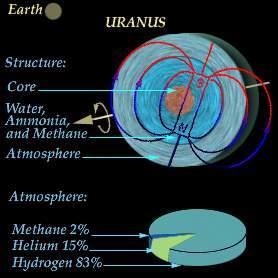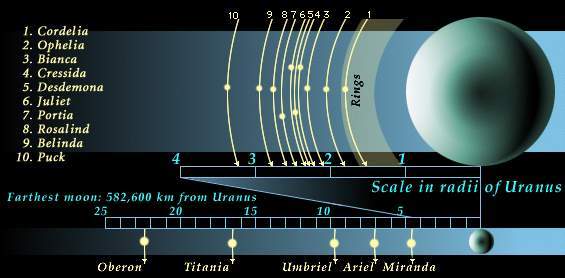|
While surveying the skies on a March evening in 1781, English astronomer Sir William Herschel discovered the planet URANUS at first mistaking it for a comet. After observing Uranus’ path among the stars, astronomers determined that Uranus’ orbit extends 19 times farther from the Sun than Earth’s orbit. Although the diameter of the planet is four times greater than that of Earth, at this distance it appears in the sky as a faint disk spanning one thousandth of a degree, making it barely visible to the unaided eye only on clear, dark nights.
|
| Physical Data |
|
| Namesake | Roman God, Father of the Titans |
|---|
| Distance from Sun | 2.871 Billion Kilometers |
|---|
| Equatorial Diameter | 51,119 Kilometers |
|---|
| Mass | 0.0000437 (Sun=1) |
|---|
| Surface gravity | 1.170 (Earth=1) |
|---|
| Mean density | 1.30 (wather=1) |
|---|
| Escape velocity | 22.5 km/s |
|---|
| Albedo | 0.51 (white=1) |
|---|
| Ellipticity | 0.03000 |
|---|
| Atmosphere (Main Components) | Hydrogen and Helium |
|---|
| Moons | (15) In increasing distance from the planet:
Cordelia, Ophelia, Bianca, Cressida, Desdemona, Juliet, Portia, Rosalind, Belinda, Puck, Miranda, Ariel, Umbriel Titania, Oberon |
|---|
| Rings | 11 |
|---|
| Inclination of Axis | 97.86 |
|---|
| Semimajor axis | 19.159 a.u. |
|---|
| Orbital eccentricity | 0.048 |
|---|
| Inclination of Orbit to Ecliptic | +46' |
|---|
| Siderial period | 83.80 Years |
|---|
| Sinodial period | 1.01 Years |
|---|
| A day (turns on axis) | 17h14m |
|---|
| Tilt of magnetic axis | -59° |
|---|
| Offset of magnetic axis | 31% |
|---|
| Magnetic field at equator | 0.75 (Earth=1) |
|---|
| Magnetopause distance | 18-25 (radius=1) |
|---|

Early astronomers observed that the orbits of the four then-known Uranian moons were tipped 98 degrees relative to the planet’s orbit around the Sun. These satellites, as well as Miranda (a Uranian moon discovered in 1948), and 10 small inner moons discovered by Voyager 2 in 1986 (bringing the total number of Uranian moons to 15), all lie in Uranus’ equatorial plane.
Uranus behaves like a giant top as it spins on an axis almost in the plane of the orbit. This motion leads to extreme seasonal variation in what sunlight is available. Over the period of one Uranian year (84 Earth years), the polar regions of the planet go through four seasons, as on Earth, with perpetual sunlight in the summer, and total darkness in the winter. Periods of alternating day and night are interspersed in the spring and fall.
With winters and summers extending for 21 Earth years, it would seem that Uranus should experience drastic temperature changes, but this is not the case. Uranus is so far from the Sun that its energy input per area is 360 times less than that on Earth; thus, little heating occurs during the summer. The rate of heat loss depends on the temperature of the region that is exposed to space; low cloud temperature leads to little heat loss during the winter. Despite Uranus’ strange seasons, the temperature of the clouds shrouding the planet remain some-what constant at -220°C.
Only one spacecraft has observed Uranus at close range—Voyager 2. The Voyager spacecraft revealed that recurring patterns in radio signals from the planet indicated a rotation period (length of day) of 17.3 hours. Voyager scientists also discovered that, while the strength of Uranus’ magnetic field is similar to Earth’s, the Uranian poles are an amazing 60 degrees away from the rotational pole.
When Voyager 2 flew by the planet, the spacecraft’s cameras revealed an almost featureless atmosphere; however, faint cloud markings between 20 and 50° S latitude were recorded. The rotation rate of these clouds compared with the rotation of the magnetic field indicated wind speeds of 100–600 km/hr., which, unlike the winds of Jupiter and Saturn, blow westward.
In 1977, Uranus was observed passing in front of a star. During this observation, it was revealed that Uranus possesses a system of at least 11 thin, widely, separated rings, In 1986 Voyager 2 confirmed that rings’ existence.
Today, we know that the dimly lit Uranian system consists of a planet surrounded by a flat system of rings and satellites. Bits of debris are concentrated into thin rings that orbit the planet with the tiny moon Cordelia orbiting inside the brightest, outermost ring. Nine other small moons orbit outside the ring system. The five outer moons, with diameters ranging from 13 to 15 percent the size of our Moon, revolve around the planet at distances one-third to one-and-a-half times the distance between Earth and our Moon. Voyager 2 revealed that a remarkable variety of surface features mark these larger satellites, including craters, fractures, and frozen water.

| Significant Dates |
|
| 1781— | Sir William Herschel discovered Uranus |
|---|
| 1787— | Sir William Herschel discovered Uranian moons Titania and Oberon |
|---|
| 1851— | William Lassell discovered Uranian moons Ariel and Umbriel |
|---|
| 1948— | Gerard Kuiper discovered Uranian moon Miranda |
|---|
| 1977— | James Elliot and others discovered rings around Uranus |
|---|
| 1986— | Voyager 2 discovered 10 small moons, and 2 more rings, detected the magnetic period, and measured the length of the Uranian day. |
|---|
|


